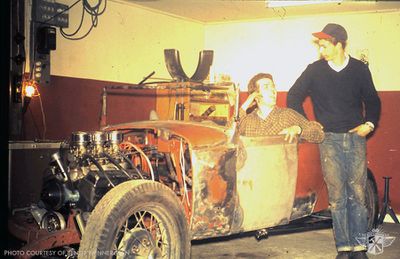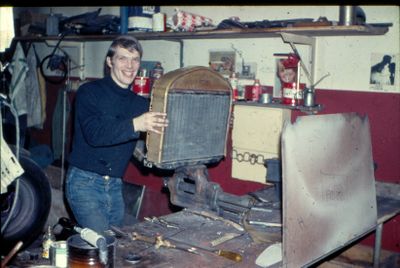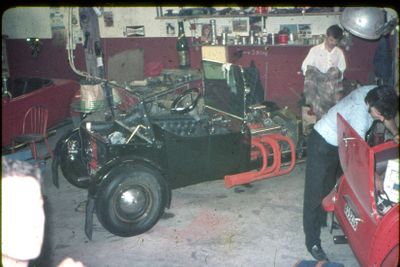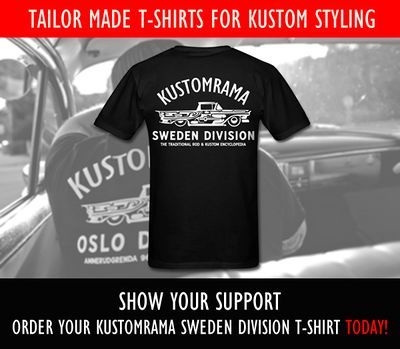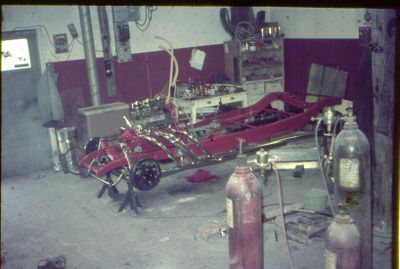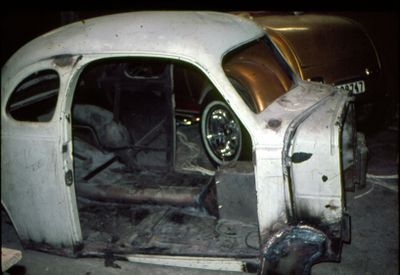The Hot Rod Barn in Sweden
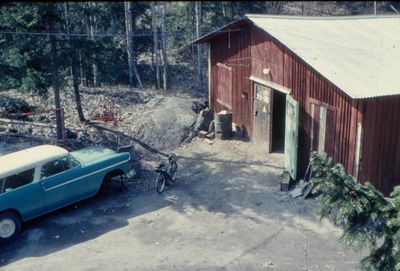
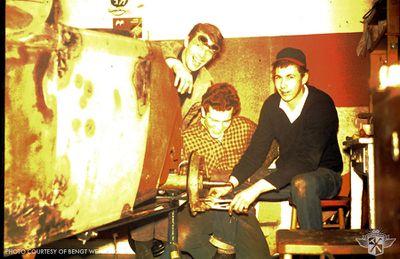

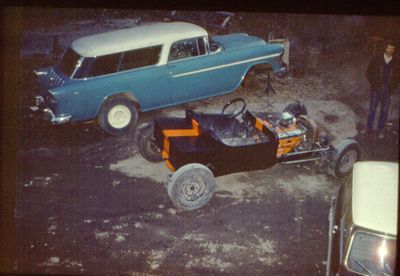





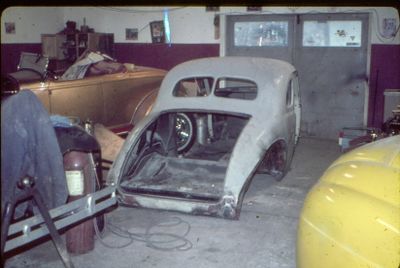
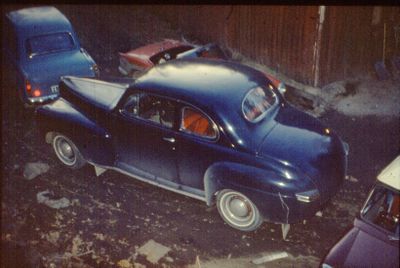

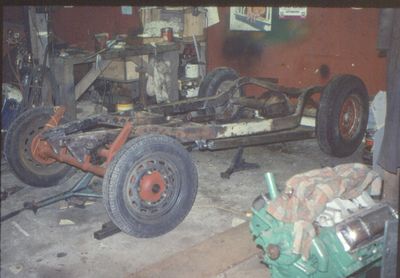
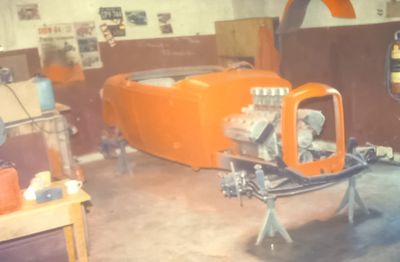

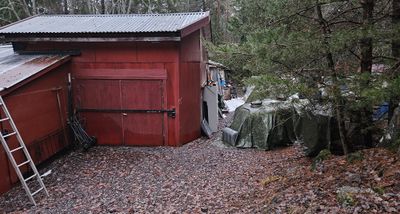
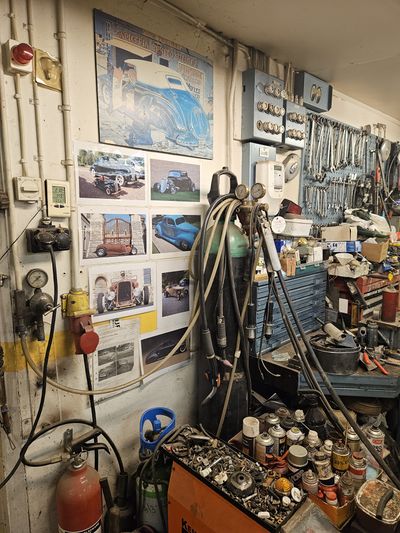
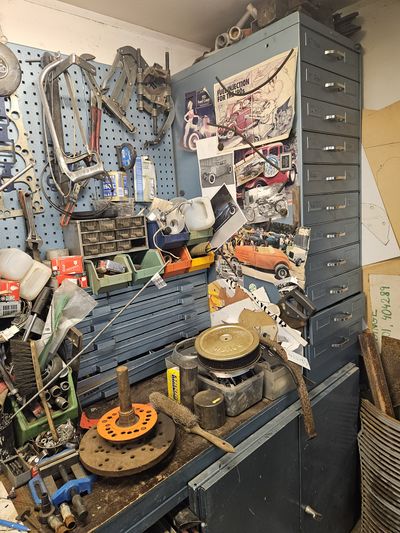
Many car enthusiasts in Scandinavia have likely heard of a legendary barn in Huddinge, located south of Stockholm, Sweden, where cars have been (and continue to be) constructed full-time![1]
Contents
- 1 Rumble in Stockholm: The Rise of "Raggare" and the Quest for Space
- 2 From Ruins to Revival: The Transformation of the Hot Rod Barn
- 3 Misjudgment to Community: The Road Knights Earn Their Reputation
- 4 The Barn's Golden Age: A Hub of Creativity and Camaraderie in the 1960s
- 5 Key Figures in the Barn During the 1960s:
- 6 Trikes, Transition, and Tragedy: The Barn in the Early 1970s
- 7 Guardians of the Legacy: The Barn's Journey into the Future
- 8 References
Rumble in Stockholm: The Rise of "Raggare" and the Quest for Space
In the late 1950s, the various American car clubs known as 'Raggare' in Stockholm began to excessively 'go wild' in the city. The police and local authorities concluded that facilities outside the city were necessary for these groups to gather. In November 1959, city councilor Inga Thorsson responded to a query regarding the allocation of available facilities between 'Raggare' and other youth organizations. Although some members of the 'Raggare' were not responsible, there was a significant need to support the more conscientious ones.[1]
A meeting took place involving representatives from the four largest gangs in Stockholm: Car Angels, The Road Devils, Teddy Boys, and Helgonen. The city agreed to assist with the issue of finding a local gathering place in exchange for the gangs' commitment to engage in social activities, such as organizing outings for the elderly and young people with disabilities. The outcome was as follows:[1]
The Teddy Boys were allocated the Sköndal barracks next to the mosaic cemetery. The Car Angels were provided with the Franzonska villa in Södertörn's villa district, which boasted 8 rooms. Meanwhile, awaiting a permanent solution, the 'Helgonen' were given a trailer bus equipped with a kitchenette positioned in Huddinge, where most of its members resided. There's no mention of The Road Devils, led by Bosse "Gamen" Sandberg. Perhaps they were considered too unruly, or maybe they chose not to agree to the terms? The details remain unclear.[1]
Those dedicated to working on rebuilt, customized cars, hopping-up 1930s Fords, were likely less organized and spread throughout the county. Some of the notable meeting spots in the early 1960s included Café Cupido on Roslagsgatan, Henry's Café at Pungpinan/Skarpnäck, Djurberg's workshop in Sollentuna, and the Bellander brothers' place in Betsede, Gustavsberg. Subsequently, Lennart "The Beard" Andersson's junkyard in Huddinge emerged as a popular gathering point for enthusiasts to meet, as well as source cars and parts.[1]
In Enskedefältet, "Sillarna" — Hasse Broberg and Kjelle Gustad congregated and worked at Hasse's parents' villa on Österbottenvägen along with Benke Wennergren and Jonny Burger. They also utilized a garage in Trollbäcken, home to Palle Eriksson and the Sandberg Brothers, Bo and Sven. In 1962, Bosse "Gamen" relocated his business, Yankee Custom Parts, from Svarvargatan to a personal residence in Örby equipped with multiple garages. Additionally, the Sandberg family owned a barn in the summer resort area of Vendelsö, where they built cars. However, the demand for garage space was significant, as many individuals sought a sheltered area to construct cars. Numerous parts were affordably sourced from scrap yards in Denmark and Norway.[1]
From Ruins to Revival: The Transformation of the Hot Rod Barn
Richard Bergström's aunt owned a summer house on Stridsvägen in Högmora, Huddinge, conveniently located near a bus terminus. Thus, Richard, Kjelle Gustad, and Ronny Haglund began constructing a garage on the property to house a Model B Ford. During their work, they stumbled upon rumors of a larger structure deep in the forest, seemingly inaccessible and recently the site of a grim police discovery—a deceased woman. This building was eventually identified as a "Newspaper House," a collection point for paper and rags, likely processed into fuel. Additionally, it functioned as a workshop for creating torches, surrounded by a vast storage area filled with various scraps near the cabins.[1]
The boys inquired about the possibility of renting or purchasing the barn, which was successful. Initially, six guys pooled their resources to buy it, with each securing a designated space inside. To the right was Richard Bergström, a guy nicknamed "Snigeln" ("The Snail"), real name Anders Säflund, who planned to work on a ‘34 coupe, and Torgny "Toddan" Johansson. The left side was occupied by Benke Wennergren, Ronny Haglund, and Lasse "Junken" Ljungqvist. Assistance came from Richard's father, who had the skills to negotiate with the municipality, leading to the signing of a lease for the land.[1]
The barn was in a deplorable state, with a packed earth floor, no ceiling, lacking interior walls or insulation, and large holes in the exterior walls, not to mention the absence of a garage door. The back portion of the structure had collapsed under the weight of snow and was beyond repair. The elderly gentleman who owned the place had moved to Bråtegränd but left behind all his belongings scattered around. This marked the beginning of an extensive effort to refurbish the barn. The person who drove a truck, humorously referred to as "Junk," collected wood and whatever materials could be found from various locations. With money being tight, they had to make do with whatever was on hand. Richard managed to secure some leftover concrete slats from a construction project, necessitating the floor to be poured incrementally, one section at a time. In their designated areas, some even inscribed their names into the wet concrete, which remains visible to this day. A lengthy beam was procured to reinforce the roof. Following this, insulation and interior walls were added, along with a fresh coat of paint, electrical fittings, and an ancient stove to provide heating.[1]
Upon completion, it marked the inaugural celebration of the "Road Knight" garage! The event was slated around New Year's 1963-1964. The moniker "Road Knight" was inspired by a comic magazine featuring Hot Rod enthusiasts who formed a club under that name. Thus, when it came time to register a name in the telephone directory for their new number, they chose "Road Knights"! Benke Wennergren reminisced that the club was scarcely more than just that in essence.[1]
Misjudgment to Community: The Road Knights Earn Their Reputation
Shortly after they moved in, the surrounding cottages—mostly summer homes at the time—were hit by a series of burglaries. Local suspicion quickly fell on the "Raggars" who had taken up residence in the barn. Discarded car parts littered the area just below. The police discovered a vehicle registration certificate among these parts, which led them to a car that had been reported stolen. This clue eventually pointed them to Skåne, where two young individuals were apprehended and admitted to the string of burglaries.[1]
Following this incident, the neighborhood's perception shifted dramatically. The locals began offering cakes, and everyone started to see the boys in a new, positive light, recognizing them as very nice and helpful individuals. Their presence in the barn became a source of reassurance for the surrounding residents. Whenever a lawnmower or bike broke down, the "Road Knights" were always ready to lend a hand, often in exchange for some coffee bread![1]
The Barn's Golden Age: A Hub of Creativity and Camaraderie in the 1960s
During the 60s, the barn saw a variety of tenants. The "Herrings" were among the early departures, as they shifted their focus to prepping their boat "Pride" for extended voyages. However, the barn quickly evolved into a popular meeting spot. As the workshop was enhanced with the addition of welders, milling machines, and lathes, it began to attract a significant number of car and motorcycle enthusiasts seeking repairs and modifications. There was a strong sense of community, with everyone eager to share tips, advice, and inspiration. While it’s challenging to acknowledge everyone involved, it was evident that most from the south of Stockholm formed a close-knit group. This camaraderie occasionally sparked romantic interests, especially as girlfriends became regular participants. This led to numerous relationships and romantic liaisons among the group—a topic perhaps best saved for another discussion.[1]
Key Figures in the Barn During the 1960s:
- Benke Wennergren with his 1931 Ford Model A Roadster that featured a chassis by Ove Kasby.
- Richard Bergström who was later replaced by Johnny Burger with his 1931 Ford Roadster.
- Jonas Qvarnström, who helped organize the Hot Rod Show, built his 1931 Ford Roadster with a wild Dodge Hemi and four Stromberg carburetors in the barn. The roadster was later turned into the "Orange Fink."
- Richard Bergström had a seat. He put together a red Metalflaked sunroofed '32 Tudor in a hurry for the Hot Rod Show.
- Richard Begrström's little brother Olle with a nice Ford Model-A Phaeton that Palle Eriksson helped out with.
- Lasse "Junken" with his '32 Roadster.
- Björn Wallman had his '32 Roadster in the barn for a period.
- Sven "Hottis" Granberg's T-23 bucket was built in the barn.
- Janne "Benjamin" Wahlström had his nice 1932 Ford 5-Window Coupe in the barn.
- Pelle Carlsson (later Stenberg), Olle Bergström, and Lasse Svensson built an Anglia called "Funny Hill" with CSB 283 for drag racing at Anderstorp in 1968.
- Lasse Svensson with his 4-door
- Tommy Andersson built his 1939 Chevrolet Coupe and was of course called "Cheva-Tommy." Before he was old enough to drive, he rode his bicycle to the barn.
Trikes, Transition, and Tragedy: The Barn in the Early 1970s
In the early 1970s, as trikes gained popularity, Anders Lake and Pelle Carlsson established the "Trike Factory" within the barn, where they operated a production line crafting frames and adapters for several years. Both Anders and Pelle created their own trikes, as well as custom orders for clients like Bosse Bertilsson and Bosse "Gamen" Sandberg. Promotional builds for Picko Troberg, including the "Cola Can" and the "Good Year" car, were also assembled here. The tragic death of Anders Lake in 1975 marked a significant shift. Pelle initiated his own workshop in his house, focusing on T- and A-Fords. Meanwhile, many others transitioned to family life, moving into homes with private garages. The enthusiasm for car building also waned, partly due to stricter inspection regulations introduced in 1970.[1]
Guardians of the Legacy: The Barn's Journey into the Future
Tommy Andersson stepped in to take over the lease and management of the barn towards the late 1970s, following Lasse Svensson and Yngve Bergström's departure. Demonstrating a strong commitment to its preservation, Tommy owned a significant portion of the shed and the adjacent land that backs onto the forest in 2024. Much of this collection originated from his half-brother Lennart "The Beard's" scrapyard, which was cleared out in 2008. The barn's interior has been meticulously maintained, and there's a strong case for its designation as a culturally significant site. The coffee corner has been the setting for countless stories, while the walls are adorned with a myriad of pictures, scribbles, and phone numbers of individuals and businesses alike.[1]
We can only hope this legacy will be preserved for future generations, even though they may not fully grasp its value!
References
Did you enjoy this article?
Kustomrama is an encyclopedia dedicated to preserve, share and protect traditional hot rod and custom car history from all over the world.
- Help us keep history alive. For as little as 2.99 USD a month you can become a monthly supporter. Click here to learn more.
- Subscribe to our free newsletter and receive regular updates and stories from Kustomrama.
- Do you know someone who would enjoy this article? Click here to forward it.
Can you help us make this article better?
Please get in touch with us at mail@kustomrama.com if you have additional information or photos to share about The Hot Rod Barn in Sweden.
This article was made possible by:
SunTec Auto Glass - Auto Glass Services on Vintage and Classic Cars
Finding a replacement windshield, back or side glass can be a difficult task when restoring your vintage or custom classic car. It doesn't have to be though now with auto glass specialist companies like www.suntecautoglass.com. They can source OEM or OEM-equivalent glass for older makes/models; which will ensure a proper fit every time. Check them out for more details!
Do you want to see your company here? Click here for more info about how you can advertise your business on Kustomrama.
